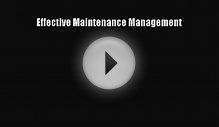
Effective Maintenance Management
The maintenance organization of today, like many departments, is under continued pressure to cut costs, show results, and support the mission of the organization. After all, it is a logical expectation from the business standpoint.
The evolving maintenance operation has been charged with supporting the broader efforts of World Class Manufacturing such as Six Sigma, Lean Manufacturing and major quality initiatives. The ability to be successful in that charter lies within the practices and systems that make up the maintenance function. It is not just what we do…it is how well we do it.
In fact, regardless of who does maintenance, whether it is a specialized skilled or multiskilled tradesperson or a highly trained operator/mechanic, solid maintenance practices are the keystone to World Class Maintenance, which leads to World Class operations.
According to Paul Thomlingson, in “Effectiveness Maintenance”, the objectives of a good maintenance function are to:
- Support operations by keeping production equipment in good condition so that production targets can be met
- Maintain the plant facilities by keeping the plant site and its buildings, utilities, and grounds in a functional, attractive state
- Conduct engineering projects like equipment modifications, construction, installation, and relocation
- Develop a program to carry out its services
- Organize itself to support the equipment maintenance needs of production while conducting essential engineering projects
- Execute its programs while utilizing its resources productively
- Perform quality work
- Anticipate and prepare for future work
- Achieve continued improvement by evaluating performance, taking corrective actions, and measuring progress
- Prepare for future changes by anticipating needs and organizing flexibly
This would be in addition to conducting those proactive activities to prevent failures from occurring.
Best Maintenance has its foundation in Best Maintenance Practices. Those practices include the following twelve areas:
- Leadership and Policy Deployment
- Organizational Structure
- Inventory Control
- Computerized Maintenance Management Systems
- Preventive Maintenance
- Predictive Maintenance
- Planning and Scheduling
- Work Flow
- Financial Control
- Operational Involvement
- Staffing and Development
- Continuous Improvement
Leadership and Policy Deployment
Let’s look at the first of these, Leadership and Policy Deployment. World Class Maintenance relies on leadership providing direction, focus and support. This involves management establishing a clear mission and vision supportive of the organization’s direction and goals.
RELATED VIDEO



Share this Post
Related posts
Building Construction related to the Fire Service
This textbook matches the course outline and objectives identified by the National Fire Academy s Fire and Emergency Services…
Read MoreIndustrial Maintenance Technology
Industrial Maintenance Mechanic I [3] MANF 211 - Industrial Maintenance Mechanic I 3-4-3 Basic principles and skills of…
Read More









